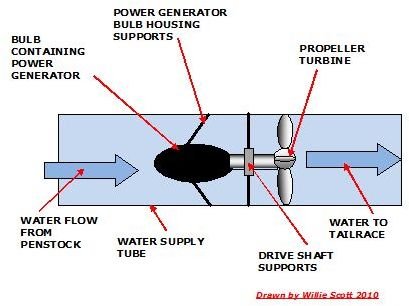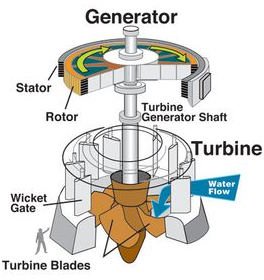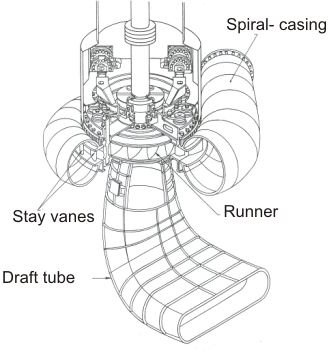Hydrokinetic Energy From Coaxial Water Reaction Turbines
Introduction to the Different Types of Reaction Turbines Used in Hydropower
Hydropower is a source of renewable energy and is the only power source to have a stored source of energy, i.e. the reservoir.
The potential energy in the falling water is converted to kinetic energy by the water turbines which drive the generators to produce electricity.
There are two different categories of water turbines used by hydropower plants today, impulse and reaction turbines, which depend on different properties of the water supply to operate them. As we examined the impulse turbines in the previous article we will look into the operational characteristics of the reaction turbine.
So what is a reaction turbine? It was primarily designed to operate efficiently under conditions which supply water at a high flow rate combined with a low head. However, some hydrokinetic experts maintain this is the most versatile of all the water turbines with some coaxial turbines being a hybrid which can also operate under high head with high flow rate conditions
The reaction turbines can be propeller or coaxial radial flow types, and are very popular throughout the world. The Francis Turbine is a radial flow type of reaction turbine and is currently operating in the world’s largest hydropower plant at the controversial Three Gorges hydropower plant in China.
This is another article in my series on power from renewable energy, and a follow-up to my previous article on hydropower. In it we will look at the reaction turbine, examining the different types of turbines within this category which operate to give optimum efficiency to the hydro plant system.
So we begin then with the types of reaction turbines.
Types of Reaction Turbines used in Hydropower Stations
This category of turbines is used where sometimes only a low head of water is available but with a high flow rate, all these turbines are enclosed in a casing and submerged in the water supply. Listed below some of popular types of reaction turbines
- Radial Flow Turbine
Francis Turbine
The Francis turbine is one of the most popular types of reaction turbine used in hydropower plants today, mainly because of its flexibility to operate very efficiently under high or low heads.
Water is introduced to the turbine through a spiral tube which is wrapped around the turbine exiting through curved adjustable vanes producing a coaxial water supply. When the water enters the turbine inlet it causes the water to swirl around the turbine blades, being of a radial contour and taper, towards the center of the runner in a vortex shape.
The water flows through the blades giving up more energy as it exits through a specially shaped draft tube. This acts as a diffuser from which water then flows out to the tailrace, having transferred all its converted potential energy and kinetic energy to the turbine.
- Propeller Turbines
Kaplan Propeller Turbine
This is a popular type of reaction turbine once again totally enclosed in a casing, the blades being fully submerged in the water. There can be various numbers of blades, depending on the water supply properties and the particular hydropower characteristics
As the name suggests the blades are of propeller shape bolted onto the hub via component which enable the pitch of the blades to be altered.
The water inlet pipe is again in the form of a spiral tube wrapped around the turbine. There are adjustable wicket gates installed in the spiral tube, and these effectively convert the water from radial flow to axial flow onto the blades.
The combination of the adjustable wicket gates angle and propeller blades pitch gives the Kaplan turbine an efficiency of over 90%.
Bulb Propeller Turbine
The bulb turbine is rather unique as it has the generator enclosed in the water as well as the turbine.
It can be installed in the horizontal or vertical position and is fitted inside in a large tube supported by steel tie rods which maintain a clearance between the component and the pipe walls. The water flows into the tube from the penstock, over the bulb containing the power generator, and through the propeller turbine and exits into the tailrace. The power generation housing is designed in the shape of a bulb to minimise water friction, the generator and its electrical cabling being completely sealed against the ingress of water.
As well as being used in hydropower plants, bulb turbines are currently installed at The Rance Tidal Barrage Plant in France, and have been operating successfully since 1966.
Sketches of Types of Reaction Turbines

Pictures and Flow Diagrams of Reaction Water Turbines



